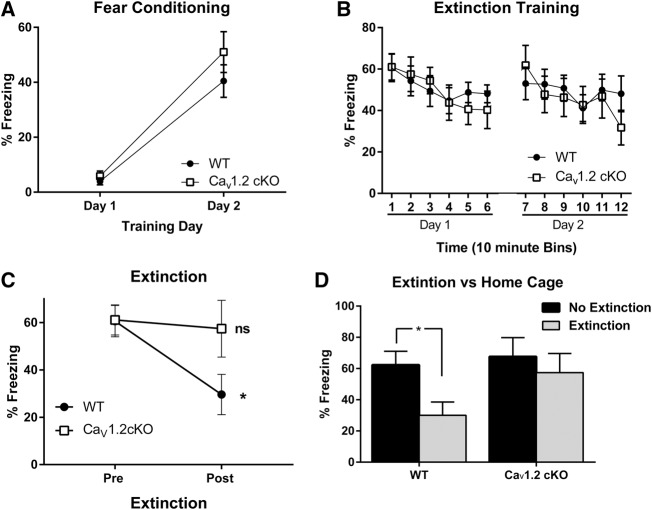Figure 3.
CaV1.2 conditional knockout mice exhibit significant deficits in fear extinction to a conditioned context. Mice were fear conditioned to a context using 3 min of context exposure followed by one unsignaled footshock presentation per day for 2 d. Mice were then randomly assigned to extinction (n = 7 and 10 for CaV1.2 conditional knockout and wild-type, respectively) or no extinction (n = 7 and 10 for CaV1.2 conditional knockout and wild-type, respectively) groups. Mice in the extinction group were extinguished using 2 h of context exposure split across 2 d. Following extinction, both extinction and no extinction mice were assessed for fear to the conditioned context during the extinction test. (A) CaV1.2 and wild-type mice showed similar fear acquisition across context training days. (B) During context extinction, CaV1.2 conditional knockout and wild-type mice exhibit within session extinction in extinction day one, represented as time bins 1–6 and extinction day two, represented as time bins 7–12. (C) When tested 24 h after extinction training, wild-type mice exhibited significantly less freezing when compared with their own freezing levels on Extinction Day 1. In contrast, the CaV1.2 conditional knockout mice froze at levels that were statistically indistinguishable from their preextinction levels. (D) When tested 24 h after extinction training, wild-type mice exhibited significantly less freezing when compared with wild-type mice that did not receive extinction training. Conversely, the CaV1.2 conditional knockout mice exhibited similar levels of freezing regardless of whether they received the extinction training. Data are represented as mean ± SEM. (*) P < 0.05.

